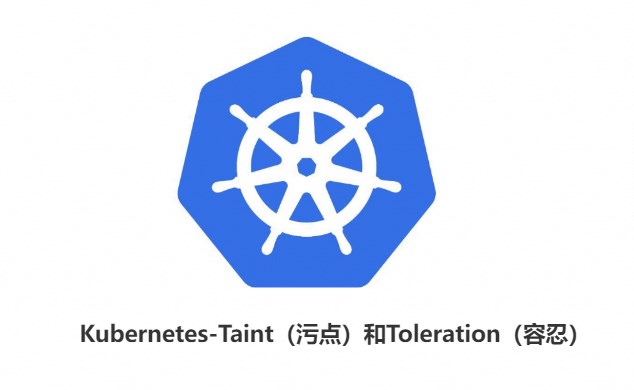
Kubernetes-Taint (污点)和 Toleration(容忍)
Taint 和 toleration 相互配合,可以用来避免 pod 被分配到不合适的节点上。每个节点上都可以应用一个或多个 taint ,这表示对于那些不能容忍这些 taint 的 pod,是不会被该节点接受的。如果将 toleration 应用于 pod 上,则表示这些 pod 可以(但不要求)被调度到具有匹配 taint 的节点上。
目录
Taint 和 toleration 相互配合,可以用来避免 pod 被分配到不合适的节点上。每个节点上都可以应用一个或多个 taint ,这表示对于那些不能容忍这些 taint 的 pod,是不会被该节点接受的。如果将 toleration 应用于 pod 上,则表示这些 pod 可以(但不要求)被调度到具有匹配 taint 的节点上。
一、Taint(污点)
使用 `kubectl taint` 命令可以给某个 Node 节点设置污点,Node 被设置上污点之后就和 Pod 之间存在了一种相斥的关系,可以让 Node 拒绝 Pod 的调度执行,甚至将 Node 已经存在的 Pod 驱逐出去
1.污点的组成
key=value:effect
每个污点有一个 key 和 value 作为污点的标签,其中 value 可以为空,effect 描述污点的作用。当前 taint effect 支持如下三个选项:
NoSchedule:表示 k8s 将不会将 Pod 调度到具有该污点的 Node 上
PreferNoSchedule:表示 k8s 将尽量避免将 Pod 调度到具有该污点的 Node 上
NoExecute:表示 k8s 将不会将 Pod 调度到具有该污点的 Node 上,同时会将 Node 上已经存在的 Pod 驱逐出去。2.污点的设置、查看和去除
kubectl taint nodes node1 key1=value1:NoSchedule
# 设置污点
kubectl describe node node-name
# 节点说明中,查找 Taints 字段
kubectl taint nodes node1 key1:NoSchedule-
# 去除污点3.污点实验:
kubectl describe node k8s-master01
#主节点自带污点,所以master节点不能被调度
kubectl taint node k8s-master01 node-role.kubernetes.io/master=:NoSchedule-
#取消master节点的污点
kubectl describe node k8s-master01
#查看污点已被删除
kubectl create deployment taint_deploy --image=nginx:latest
#创建名为taint_deploy的deployment,使用nginx:latest作为pod内容器创建的镜像。
kubectl scale deployment taint_deploy --replicas=20
#设置刚刚创建的deployment的pod副本数为20
kubectl get pod -o wide
#观察刚刚创建的pod,因为取消了master节点的污点,所以pod可以被调度到master节点运行了
#master节点没有污点的情况下,运行daemonset,master节点也会运行一个daemonset。二、Toleration(容忍)
设置了污点的 Node 将根据 taint 的 effect:NoSchedule、PreferNoSchedule、NoExecute 和 Pod 之间产生互斥的关系,Pod 将在一定程度上不会被调度到 Node 上。 但我们可以在 Pod 上设置容忍 ( Toleration ) ,意思是设置了容忍的 Pod 将可以容忍污点的存在,可以被调度到存在污点的 Node 上。
pod.spec.tolerations
1.容忍设置的方案
tolerations: #容忍
第一种方案:
- key: "key1" #指定污点的key1
operator: "Equal" #运算符等于
value: "value1" #value是污点value1
effect: "NoSchedule" #策略是NoSchedule
#这种写法的含义是key,value,effect必须全部匹配,有一个不一样都匹配不到。
第二种方案:
- key: "key1"
operator: "Equal"
value: "value1"
effect: "NoExecute"
tolerationSeconds: 3600 #容忍3600秒
第三种方案:
- key: "key2" #只要匹配到key和dffect,value是什么无所谓。
operator: "Exists"
effect: "NoSchedule"
例:
Ⅰ、当不指定 key 值时,表示容忍所有的污点 key:**
tolerations:
- operator: "Exists" #只写一个存在,只要有污点,就能容忍
Ⅱ、当不指定 effect 值时,表示容忍所有的污点作用**
tolerations:
- key: "key"
operator: "Exists" #只要key匹配到了,其他的无所谓
Ⅲ、有多个 Master 存在时,防止资源浪费,可以如下设置
kubectl taint nodes Node-Name node-role.kubernetes.io/master=:PreferNoSchedule
2.容忍实验:
kubectl taint node k8s-master01 node-role.kibernetes.io/master=:NoSchedule
#将主节点的污点恢复回来
kubectl get daemonset -n kube-system
#查看有哪些daemonset资源
kubectl get daemonset -n kube-system calico-node -o yaml
#查看calico的容忍
#策略NoSchedule,运算符Exists(存在),key和value无所谓
#value和策略无所谓
#还能容忍NoExecute策略的,value和key无所谓

kubectl describe node k8s-master01
#查询master节点的key
vim tolerations_daemonset.yaml
apiVersion: apps/v1
kind: DaemonSet
metadata:
name: tolerations-daemonset
labels:
app: daemonset
spec:
selector:
matchLabels:
name: tolerations-daemonset-pod
template:
metadata:
labels:
name: tolerations-daemonset-pod
spec:
tolerations:
- key: "node-role.kubernetes.io/master" #master节点的污点的key。
operator: "Exists" #匹配规则为exists,存在key就容忍。
containers:
- name: tolerations-daemonset-pod
image: nginx:latest
imagePullPolicy: IfNotPresent
kubectl apply -f tolerations_daemonset.yaml
kubectl get daemonset
#查看创建的daemonset
kubectl get pod -o wide
#查看daemonset的pod是否调度在master上。更多推荐
 已为社区贡献1条内容
已为社区贡献1条内容






所有评论(0)